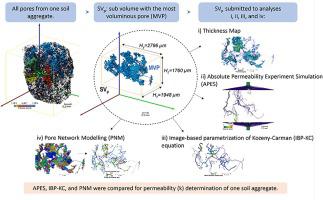Journal of Hydrology ( IF 5.9 ) Pub Date : 2022-06-16 , DOI: 10.1016/j.jhydrol.2022.128024 Talita R. Ferreira , Nathaly L. Archilha , Luiz F. Pires

|
Nowadays there are many papers dealing with the analysis of the soil porous system through X-ray computed tomography (XCT). However, a reduced number of studies focus on modeling the intrinsic permeability (k) of complex porous media, such as soil, based on three-dimensional (3D) high-resolution images. The determination of k is fundamental to understanding several processes taking place in soil such as water and air transmission. Thus, this paper compares three XCT-based methods for estimating the k of the pore system of soil aggregates: i) Finite volume-based simulation (APES - Absolute Permeability Experiment Simulation), ii) Image-based parametrization of the Kozeny-Carman (IBP-KC) equation, and iii) Pore network model (PNM). The 3D image considered in the comparison of methods was acquired at the X-ray microtomography beamline at the Brazilian Synchrotron Light Facility, with a voxel size of 1.64 μm. APES was considered as a reference method for being less dependent on the configuration of sensitivity parameters. APES and PNM demonstrated to be more time consuming than the IBP-KC, the first taking longer among all for the k computation. PNM presented the drawback of higher sensitivity to thin pore ramifications, resulting in unrealistic values of k and requiring disconnecting one thinner pore to yield permeabilities comparable to the ones obtained by APES. This study demonstrated that a fine alternative to compute k for large image datasets is to calibrate faster methods (e.g., IBP-KC and PNM) against a slower but more reliable reference method (e.g., APES), using at least one 3D image, before applying the faster methods on the remaining images of the dataset.
中文翻译:

分析三种基于 XCT 的方法来确定土壤团聚体的内在渗透性
目前有许多论文涉及通过 X 射线计算机断层扫描 (XCT) 分析土壤多孔系统。然而,较少的研究侧重于基于三维 (3D) 高分辨率图像对复杂多孔介质(如土壤)的固有渗透率 (k) 进行建模。k 的确定对于了解土壤中发生的几个过程(例如水和空气传输)至关重要。因此,本文比较了三种基于 XCT 的估算土壤团聚体孔隙系统 k 的方法:i)基于有限体积的模拟(APES - 绝对渗透率实验模拟),ii)基于图像的 Kozeny-Carman 参数化( IBP-KC) 方程,以及 iii) 孔隙网络模型 (PNM)。方法比较中考虑的 3D 图像是在巴西同步加速器照明设施的 X 射线显微断层扫描光束线上获得的,体素大小为 1.64 μm。APES 被认为是一种参考方法,因为它较少依赖于灵敏度参数的配置。APES 和 PNM 被证明比 IBP-KC 更耗时,第一个在 k 计算中花费的时间更长。PNM 的缺点是对细孔分支的敏感性较高,导致 k 值不切实际,并且需要断开一个较细的孔以产生与 APES 获得的渗透率相当的渗透率。这项研究表明,为大型图像数据集计算 k 的一个很好的替代方法是针对较慢但更可靠的参考方法(例如 APES)校准较快的方法(例如 IBP-KC 和 PNM),











































 京公网安备 11010802027423号
京公网安备 11010802027423号